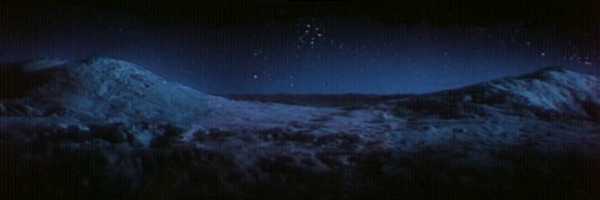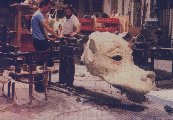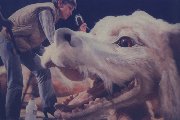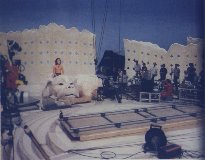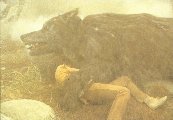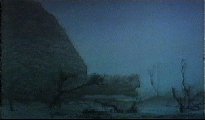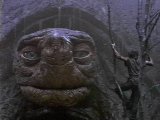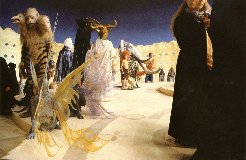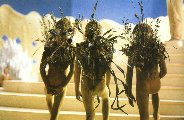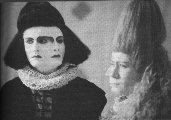|

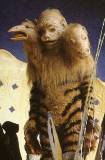

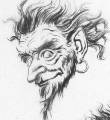
Many fantastic creatures can be found in the original novel by Michael Ende, and
many found their way into the script and unto the screen. But creating them
was not an easy task as both the imagination of Painter Ul de Rico, as the
technical skills of the special effects team, had to be taken to their limits. The following
creatures were designed and created:
Atleast two differend models of Falkor were used in the "Neverending Story".
The first and most imposing one, was over 15 meters long with a tail measuring
around 4 meters, a neck of 3 meters and a head with a weigth of 100 Kg.
Constructed by Guiseppe Tortura, the frame was made of airplane steel. Because
of its size, only special parts could be moved. It had 16 moving facilities
which controlled 36 tackles enabling this Falcor to speak, laugh, roll its eyes,
twinkle and frown. The skin contained around 10000 handsized scales and 100 kg
of pink Angora-wool. The face of the Luckdragon was created by Arthur Collin who
had to make several tries untill the final version was to the directors content.
To create the movements and expressions of the Dragon, a team of technicians
had to closely work together to control all of the tackles. As natural movement
could only be achieved through perfect coordination, a lot of practice was required
while the actual scenes were displayed at several TV screens to allow each technician
to observe the effects of his work.
The large model was used in the flying scenes with Noah Hathaway or Barret Oliver
on top, at the cave of Engywok and
Urgl and at the end laying in the Magnolia-blossoms of the Ivory Tower. Today, two
large models still exist. One of them can be found at the Bavaria Studios in Munich
where visitors can ride on a sadle on the back of the beast, whether this is the original
Falkor as seen in the first Neverending Story movie or a special ride constructed later
is unclear. A second big model, the one actually used in the second movie, can be
found somewhere in Babelberg.
The second model used in the first "Neverending Story" movie, only measured 40 cm
in length and took half a year to develop. In spite of the difference in the size with its bigger brother, it had to
look identical. Thus the designer had to glue around 2000 pinhead-sized scales while
fur of a rabbit was used to mimic the Angora-wool. The little model was fully movable
in 24 directions and was controlled electronically by an invisible control bar.
The model was used in the flying scenes where the whole dragon could be seen, like the scene
where Falkor swoops out of the sky to save Atreyu from the Gmork and the Swamp of Sadness.
|
|
|
|
|
As building a whole Gmork for the few scenes where it is seen moving, would have
been to expensive, only a single giant head was made with the ability of 59
different movements of the lips, nose, tongue and so on, to mimic speech. As with
the Luck-dragon, the head itself was designed by Arthur Collin and constructed by
Juan und Guiseppe Tortora and their team.
The head was controlled by a team of 17 technicians under the coordinaton of
Bob Easton. Again, as with the Luck-dragon, a lot of practice was required
while the scenes were displayed on several TV screens to allow each technician
to observe his work. In the end, all of the scenes were shot in a mere two hours.
|
Of all the creatures of Fantasia, the sheer size of Morla the ancient
one made her one of the biggest challenges of the special effects team.
The script indicated that the hight of the turtle would have to be around 15
meters, as building a single large model would have been to big an effort,
especially within a studio, three differend models of differend size had to
be build.
The smallest model was only 50 cm in hight and carried a toysized Atreyu-figur
on her back. This model was only seen in the movie from a side view and from
a large distantance. As this view did not require any special movements, it
was sufficient that the model just moved up and down.
The second model was of a 3 meter medium size and constructed from calcium
sulphate, chicken wire, and wood. The movements of the head were realized by
tackles and a controller crew like with the Luck-dragon and the Gmork. The
dialog between Atreju and Morla were shot separately with Noah Hathaway playing
his part in front of a blue screen.
The third model of the Morla wasn't actually a turtle but a 10 m high
mud-chute which ended 2 meters above the ground. Only a small part of Morla's
armour could be see in the shot where Atreyu glides down her shell and
drops into a pool of mud, namely the breaking tree on top of the shell
and the chute itself from which Atreju glides down. The materials used in
this model were the biggest problem as so many buckets of mud were emptied
in the day lasting shooting, that the decorations slowly started
to dissolve.
|
|
|
|
|
|
At the Ivory Tower, messengers of all races of Fantasia were to meet
to beseek the Childlike Empress for help. A total of 78 creatures stood
on the set, among them birdmen, giant heads, gnomes, two-faced people and
lots lots more. Creating such a diverse and odd-looking crowd was an
obvious difficult and expensive task for the Special Effects team, and
even though 78 creatures were made, the camera still had to be positioned
in such a way that a maximum number of them were to be seen in the shots.
Especially the two-faced creatures were remarkable considering the SFX
technology at the time. Created by Nigel D.Trevessey, masks with a second
face were made that resembled the actors who would wear them. The common
eye in the middle was moved electronically.
The one creature who would have a major part in the Ivory Tower scene,
was the chief doctor Cairon. In the original novel by Michael Ende, he was
a zebra-like centaur but for one reason or another that idear was dropped.
In the first realisation of the script, he was destined to be a water
creature that would be carried around in a bathtub. But that idear was
dropped as the weight of the water would have made it to heavy to be
realized. Thus actor Moses Gunn was dressed up with a comblike bone on
his head and wearing arised shoes. This and his long cape made it very
hard for the actor to move around without stumbling, which he reportedly
did one time without getting hurt.
|
Originally, the Nighthob was to be played by an automaton
like Falkor and the Gmork, and a lot time and money was invested into it.
But the result just didn't look the part (actually it looked like a giant
sausage) resulting in the SFX creature to be eliminated from the production
and an actor to be hired. Proud as he was but not realising how much time
make-up would take each day, it was Tilo Prückner who finally got
the part.
Designed by Colin Arthur, the actual make-up would take 4 hours to put on
and almost one hour to remove again after a hard days work. The transformation
of Tilo Prückner into the Nighthob started with 12 rubber face pieces. Then
he was fitted the gloves with the claws, followed by the teeth, the monstrous
forehead and finally the feet. To allow the make-up and all of the Nighthob
pieces to be removed afterwards without causing any pain, all of Mr. Prückners
facial hair and all of his hair on his arms and legs, had to be shaven off.
|
|
|
|
|
|
With a height of 2.30 meters, the Sleepy Bat had
to be specialy designed to both hang upside down from a branch and to
be able to mimic flying through the air with the Nighthob hanging on a tackle
beneath it.
Because of the nature of the seperate scenes, a complete lifesize
model of the Bat had to be made. But as it did not need the ability
to mimic speaking, the controls were kept relatively simple.
To simulate breathing, two persons used a bellow to pump the chest
up and down while another person moved the nostrils and a fourth one
controlled the eye-lids.
|
The 3.5 meters long Racing Snail was the first of the SFX creatures to be
finished and costed around half a million to make. Designed by Colin Arthur,
it took 7 persons to control all of the head movements which was largely made
out of rubber foam and electronics to mimic facial expressions. The whole
creature had a weight of around 200 Kilograms and was equiped with a strong
electromotor to allow it to race through the Howling Forests at great speed
while a lot of dust was blown out through nozzles at the bottom to create a
realistic impression of the ride.
Unfortunaly the snail was overpowered, causing it to break out of its
track with the rider and the snail tumbling into the decorations. It took
three days to finish all of the scenes in which the snail appeared.
|
|
|
|
|
|
One of the most impressive creatures of "The Neverending Story", three
differend models had to be used to bring the Rockbiter to life.
The first model (of the Rockbiter in a sitting position) had a size of 1.60 meters
and consisted largely of painted foam rubber. It was used in the scenes at the
campfire, in the ruïned city and beckoning to Atreyu and Bastian. It took
eight puppet-player to control all of the levers and slides that worked the
Rockbiter's eyes, cheeks, ears, upper lip, nose, fingers and forehead.
As with the Falkor model, video screens had to be used to allow each controller
to see the results of their work.
The second model was the one of the Rockbiter driving on his bike. Only
the eyes and the feet needed to be moved on this model, which was done with
remote control. The heavy stone bike was powered by a electromotor at the
front axle, with the batteries stored in the saddle, to allow it to move.
As with the Snail, the drive was too strong for the 100 kg model, especially
as the vehicle had no external brakes.
The third model was only used in the one scene where the Rockbiter
dismouned from his bike. As no mechanical model was able to make these kinds
of movements, an actor had to be found to slip inside a Rockbiter costume.
At first a tall person was looked for, but as they were unable to find
anyone tall enough, they finally had to settle for a shorter actor. In the end,
actor Colin Guilder got the part. The costume made for him to wear had a
weight of 20 kg, had an eye slid in the stomach to allow him to see, was very
hot to wear and very hard to move in. One time, the actor fell down on the set
and had to be helped up again as the suit made it impossible for him to
stand up by himself.
|
|




